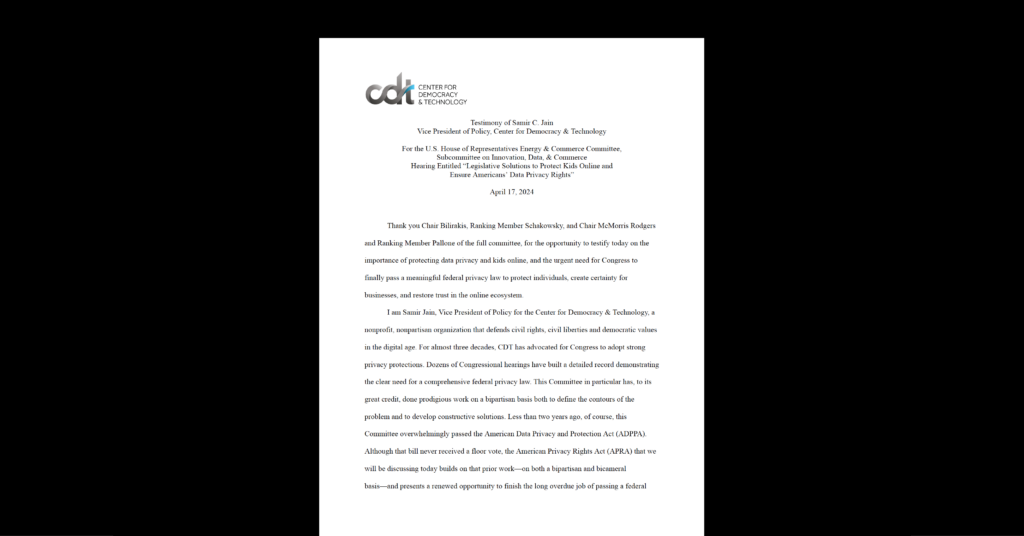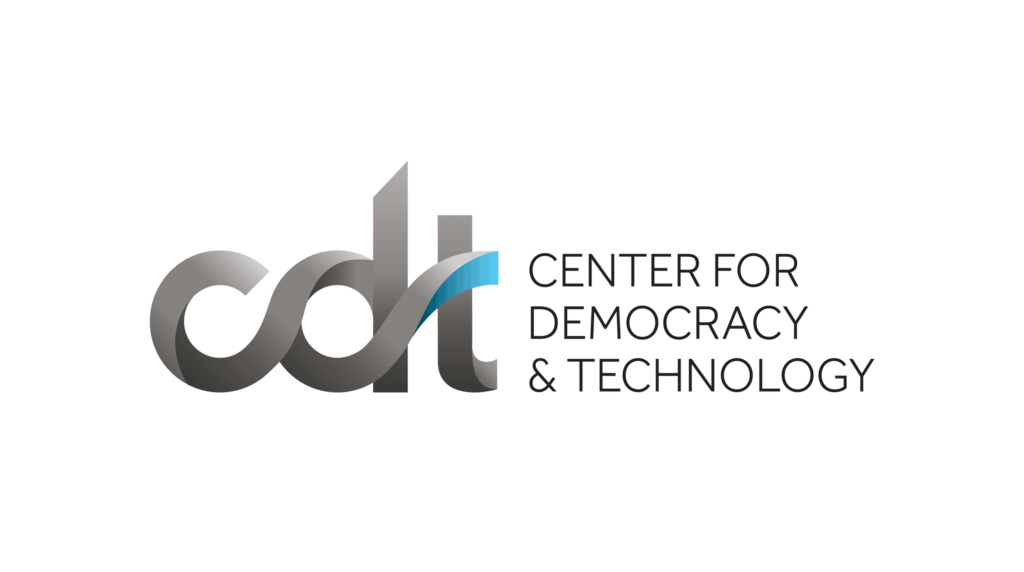AI Policy & Governance, Privacy & Data
Data Use In The Fight Against COVID-19 Should Treat People Equitably, Not Exacerbate Long-Standing Disparities
As government leaders, policymakers, and technology companies continue to navigate the global coronavirus pandemic, CDT is actively monitoring the latest responses and working to ensure they are grounded in civil rights and liberties. Our policy teams aim to help leaders craft solutions that balance the unique needs of the moment, while still respecting and upholding individual human rights. Find more of our work at cdt.org/coronavirus.
The coronavirus pandemic has raised questions globally about how companies and governments use our data in their response efforts. As governments explore ways to use this data, companies are developing apps and programs to facilitate contact tracing, location tracking, and symptom checking. Companies can play a crucial role in monitoring infection, but they must be careful that technologies created with the best intentions do not further a history of disparate impact.
Data is incomplete, but initial reports show disparities in how the virus is affecting people.
Right now, there is insufficient data about how different groups are being affected by the coronavirus. The little data currently reported exhibits racial disparities in the impact of the coronavirus. The few states that are reporting racial data found that more Black people are dying from COVID-19 than other racial groups. In areas like Michigan, Illinois, New York City, Florida, and Louisiana, Black people make up a higher percentage of COVID-19 deaths than they do the general area population, and Latinx people are also dying at higher rates. Additionally, as this letter signed by five U.S. senators and 27 U.S. representatives persuasively describes, there is reason to believe that individuals with disabilities are facing a real danger of discrimination in medical treatment.
While the Centers for Disease Control and Prevention (CDC) has released race data for outbreaks in the past, it has not explained why it is not doing so for COVID-19. While limitations on collecting race and other data may be justified in some circumstances — hospitals and testing centers are citing employee privacy and patient confidentiality in refusing to report numbers of cases and tests performed — data collection is a crucial element to understanding the impact of the pandemic. We must find ways to balance privacy and these important public health interests.
Existing societal structures have disparities that are affecting transmission, detection, and care.
Because the coronavirus is transmitted through close contact with other people, public health officials are recommending self-quarantine as one of the most important steps for keeping people healthy and stopping the spread of the virus. Not everyone can do so easily; there are many structures in place that make it more likely that disadvantaged groups cannot self-quarantine and may not be able to get help if they do get sick.
- Employment: Essential sectors include transportation systems, food and agriculture, and commercial facilities, and Black and Latinx people make up the greatest percentage of these positions. The nature and restrictions of their jobs make them more likely to continue working onsite during the pandemic, frustrating the ability to self-quarantine as directed by health experts. People in these jobs risk loss of income and may have no paid sick leave if they refuse to work onsite, leaving no other option but to come in to work. Working onsite may itself subject employees to more surveillance and scrutiny. For example, retailers are collecting data to monitor employees’ health during the current crisis.
- Housing: Minorities face residential segregation, often resulting in overcrowded households and neighborhoods that makes social distancing difficult. Credit scores and criminal records are among proxies for race that allow algorithms to be used to discriminate against rental and mortgage applicants and limit where minorities can live. Urban hospitals are likelier to close down than suburban hospitals regardless of performance, leaving residents to rely on affordable community health centers rather than traveling for treatment. As the country observed during the H1N1 outbreak, urban crowding and reliance on public transportation contribute to greater exposure and susceptibility in communities of color.
- Healthcare: Studies on the coronavirus show that underlying conditions cause a more severe form of COVID-19. Latinx, Black, and Native American people have higher rates of cancer, heart disease, lung disease, and diabetes and higher rates of comorbidity, all of which can make the symptoms of the coronavirus more extreme. Susceptibility is heightened by the fact that low-wage jobs often do not offer health insurance, and minorities may not know of all resources available to cover healthcare costs, so they are less likely to obtain help for underlying conditions and resulting coronavirus infections. For those who can afford medical care, medical decisions still incorporate broader implicit biases of the general population, preventing protected groups from being treated sufficiently for underlying conditions.
Technology should acknowledge these disparities and use data to help meet the needs of the underserved instead of obscuring their unique challenges.
The first generation of tech and data tools in the coronavirus fight has sometimes failed to account for differences among demographics. As our understanding of the disease evolves, companies and governments should be mindful of how data or data interpretations may have biases baked into them. Data should be used to explore whether current advice and services are working for people of color, people who are disabled, low-income individuals, and more.
- Tracking mobility as a proxy for social distancing: As income levels increase, so does the ability to practice social distancing. Mobility data used to monitor compliance with social distancing guidelines may not necessarily reflect who is trying to comply and who is disregarding guidelines. In cities, urban crowding as described above complicates people’s best efforts to maintain a safe distance. Noncompliance may go undetected in rural areas, where homes are spaced out and people travel mainly by car. Unacast, which created a “Social Distancing Scoreboard,” acknowledges that distance traveled does not necessarily reflect social distancing. Data about travel within and between urban, suburban, and rural areas used to determine social distancing compliance will have to account for differences in residential landscapes and transportation options to accurately identify where social distancing is being practiced most effectively.
- Using positive tests as a proxy for who is ill and where resources should go: Untested people who are infected tend to be excluded from infection and death statistics, affecting who gets resources. Fewer testing centers are being opened in areas with higher populations of Black people, and billing in several states indicates that Black people with symptoms are less likely to be referred for testing. Native American reservations are located in rural areas hours away from testing sites. The Latinx population may be hesitant to get tested or disclose for fear of putting their immigration status at risk due to current immigration policies. Wealthier people are more likely to obtain tests; cities tend to be wealthier overall than rural areas but also have greater wealth gaps within them, reflected in disparities in the data on cases reported.
- Accessing technology: Companies are collecting smartphone data and other information to help analyze infection, but consistent and adequate reporting requires equitable technology access. Minorities are less likely to have steady monthly cell phone plans and home broadband service. Fewer adults with annual household incomes below $30,000 own a smartphone or computer. People with disabilities are more likely to have lower incomes, and phones available to them under the federal Lifeline program are not smartphones with accessibility features, making them inadequate for contact tracing. Without broadband access and devices that allow connectivity, data from protected groups may fall through the cracks when analyzing how to distribute aid and resources.
Companies should keep these factors in mind when developing apps and software intended to be tools against the coronavirus. They must ensure that the data they use accurately reflects how the coronavirus affects different protected groups. Companies have an opportunity to engage in thoughtful practices that help to limit disparate impact and to make sure that no group is left behind in this fight.


